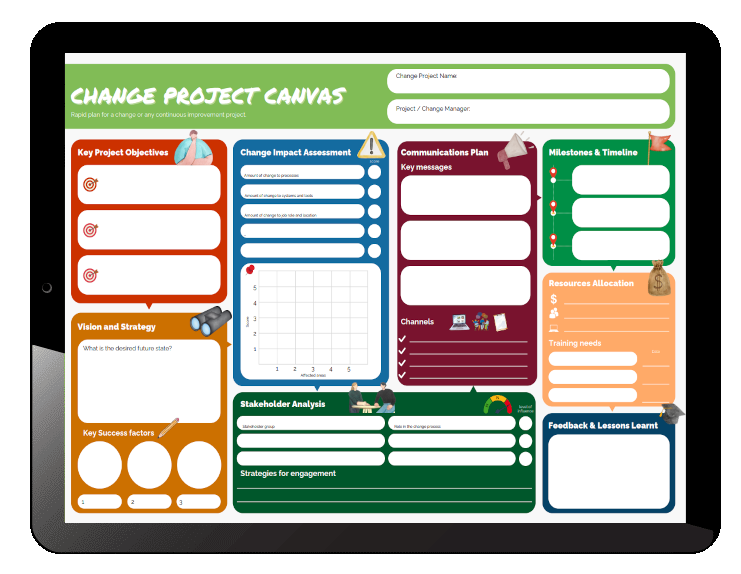Learn straightforward techniques to manage and mitigate resistance to change
As a change manager, you're acutely aware of the psychosocial hazards that can arise from poorly managed change initiatives. Resistance to change is a natural human response, but left unchecked, it can derail even the most well-intentioned projects. The key to turning resistance around and mitigating these risks? Building resilience.
Understanding Resilience
Resilience is the capacity to recover quickly from challenges, adapt to change, and thrive amidst adversity. It's a crucial attribute for both individuals and organisations navigating the complexities of change.
Resilient teams often reveal three attributes whereas resistance often comes from the lack thereof. Enhancing resilience reduces feelings of vulnerability and stress, which negatively affect our behaviour, well-being, and productivity.
⚙️ Control
Resilient leaders assess what is within or outside of their circle of control and then direct their engagement towards the aspects they can change or influence and reframe their attitude towards the aspects they can’t control.
The fear of losing control or autonomy in the face of change is a major driver for resistance behaviour and conflicts at work.
During an organisational restructuring, a team leader expresses concerns about losing their decision-making powers. Such feelings of losing control can lead to resistance among team members.
To build resilience as part of your change strategy make sure that you empower your stakeholders by involving them in the design and transition process. Regularly communicate the reasons behind changes and co-create how their roles may evolve. This inclusion fosters a sense of control and ownership, smoothing the transition.
🤝 Commitment
Organisational and individual resilience are boosted when employees and employers share a common vision, beliefs, and values. Resilient leaders keep their goals in sight and develop action plans to achieve them.
Resistance often festers when stakeholders struggle to maintain commitment to their north star because of so much uncertainty.
A department is transitioning to a new software system, and some employees are hesitant to commit to the steep learning curve, fearing it will add to their busy schedule and distract from their core work.
To build resilience as part of your change strategy make sure that you draw a roadmap to what the future will look, feel, and sound like. What long-term benefits, such as professional growth or less administrative work await the committed stakeholder? What training or support will allow them to achieve small victories and build momentum?
💪 Challenge
It’s easier said than done, but much of resilience is within our attitude and mindset. A Growth Mindset embraces tasks that stretch our abilities and provide significant opportunities for learning and growth. A Fixed Mindset on the other had has difficulties to embrace change for the fear of failure.
The introduction of a new project management framework is viewed as a challenge and criticism of the team’s current capabilities, causing defense and apprehension about their ability to meet expectations.
The good news is that mindsets are contagious. So to build resilience as part of your change strategy make sure that there is adequate support and resources (especially time) available for team members to try and develop the necessary skills. Create a micro-learning environment that encourages experimentation and allows for trial and error as a part of the growth process. Set realistic milestones and celebrate effort rather than outcomes to motivate and boost resilience.
By addressing the three C's with empathy, optimism, and perseverance, change managers can guide their teams through transitions more smoothly, building resilience along the way.
The Visualisation Walk: A Step-by-Step Guide
One effective tool for building resilience and commitment is visualisation. By mentally rehearsing successful outcomes and focusing on the desired state, individuals can develop the emotional and mental fortitude needed to persevere through challenges.
Our favourite way to visualise is to combine visualisation with physical movement during a Visualisation Walk. This mindfulness practice allows you to align your daily habits with your goals and vision, boosting motivation and resilience in the process.

Maybe next time when you prepare your change management strategy, incorporate practices like the Visualisation Walk, a collaborative vision board & transition roadmap, or a co-creation workshop. You're not only mitigating the risks associated with resistance but also cultivating a culture of resilience, perseverance, and optimism.


Looking for a FREE Project Plan on A Page? The Change Management Canvas
A Step-by-step Guide For Your Next Big Change

Sam is one of the authors of The 6 Cents of Change. He's a father, a CEO, an Engineer, a trainer and a problem-solver. His work impacted Apache, Santos, MMA, and more. In his other life, he loves CrossFit and cricket.
To learn more about us and the solutions we provide, subscribe to The 6 Cents of Change, follow us on LinkedIn or connect with us here info@approach-services.com or +61 (08) 610 20 343.




